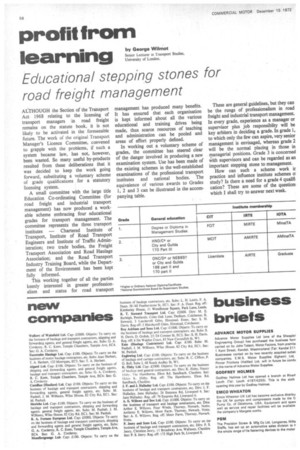profit from learning
Page 60

If you've noticed an error in this article please click here to report it so we can fix it.
by George Wilmot
Educational stepping stones for road freight management
ALTHOUGH the Section of the Transport Act 1968 relating to the licensing of transport managers in road freight remains on the statute book, it is not likely to be activated in the foreseeable future. The work of the original Transport Manager's Licence Committee, convened to grapple with the problems, if such a system became law, has not, however, been wasted. So many useful by-products resulted from these deliberations that it was decided to keep the work going forward, substituting a voluntary scheme of grade qualifications for a statutory licensing system.
A small committee with the large title Education Co-ordinating Committee (for road freight and industrial transport management) has now produced a workable scheme embracing four educational grades for transport management. The committee represents the three transport institutes — Chartered Institute of Transport, Institute of Road Transport Engineers and Institute of Traffic Administration; two trade bodies, the Freight Transport Association and Road Haulage Association; and the Road Transport Industry Training Board, while the Department of the Environment has been kept fully informed.
This working together of all the parties keenly interested in greater professionalism and status for road transport management has produced many benefits. It has ensured that each organisation is kept informed about all the various educational and training drives being made, thus scarce resources of teaching and administration can be pooled and areas of effort properly defined.
In working out a voluntary scheme of grades, the committee has steered clear of the danger involved in producing a new examination system. Use has been made of the existing schemes in the well-established examinations of the professional transport institutes and national bodies. The equivalence of various awards to Grades 1, 2 and 3 can be illustrated in the accompanying table. These are general guidelines, but they can be the rungs of professionalism in road freight and industrial transport management. In every grade, experience as a manager or supervisor plus job responsiblity will be key arbiters in deciding a grade. In grade 1, to which only the few can aspire, very senior management is envisaged, whereas grade 2 will be the normal placing in those in managerial positions. Grade 3 is concerned with supervisors and can be regarded as an important stepping stone to management.
How can such a scheme work it practice and influence institute schemes ol study? Is there a need for a grade 4 qualifi cation? These are some of the question: which I shall try to answer next week.




































































































